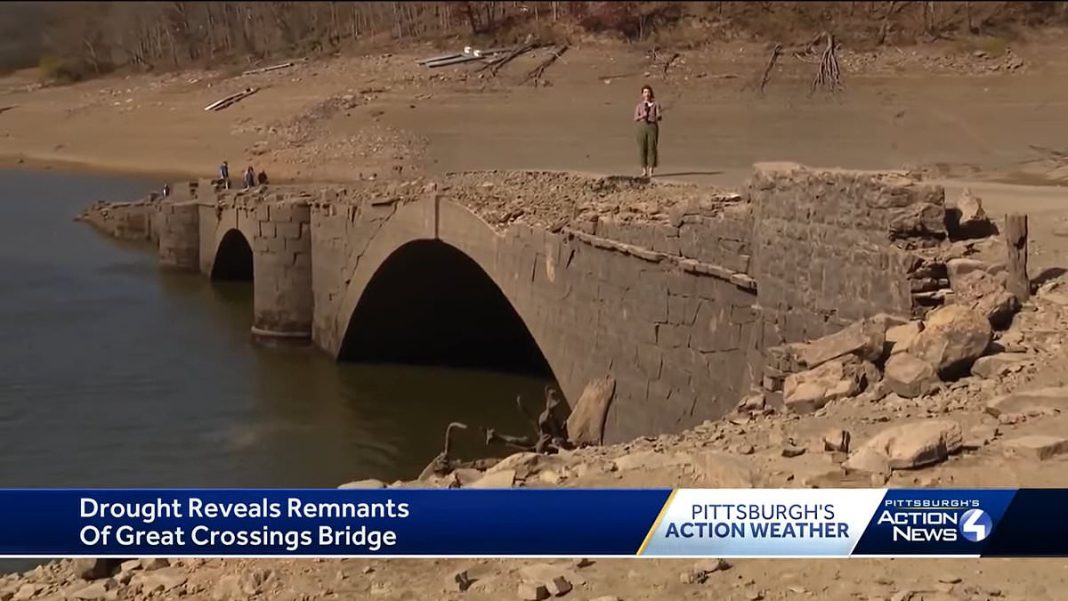Weeks of drought in US state reveals remnants of 200-year-old bridge,
Weeks of drought in western Pennsylvania have caused river levels to sink so low that the historic Great Crossing Bridge has resurfaced for the first time in decades.
The 200-year-old bridge, an 1818 structure of cut sandstone, typically lies 50 feet beneath the surface of the Youghiogheny River Lake.
But the lake, which has an average water elevation of 1,439 feet above sea level, was at 1,378 feet on October 18 and had dropped by an additional four feet as of Friday.
The Great Crossing Bridge was built to connect Fayette and Somerset counties, which have been affected by weeks of drought.
This is the first time the three arches of the bridge have been visible since 1998 and only a few times in the last 80 years has the structure been visible and traversable.
The rare event caused excitement in the area as people drove from miles away to walk across the historic structure for a once in a lifetime experience.
Officials are predicting water levels will recover in the next few weeks as winter typically brings major snowfall and heavy rain to the area.
October was an exceptionally dry month across the Northeast US.
Parts of some states – including Pennsylvania – set records for longest consecutive number of days without measurable precipitation, according to the Northeast Regional Climate Center.
Philadelphia recently broke its 150-year record for the most dry days in a row, marking it s 29th-straight day on October 28.
Vince Klinkner, the resources manager at Youghiogheny River Lake, told WTAE: ‘I see at least seven different articles, showing where the bridge has been out and kind of doing the same story that we’re doing here today.
‘Ranging from the early ’70s up until now.’
But the river lake is not at its record lowest water level. In fact, it’s ‘not even close to a top three at this point,’ he continued to explain.
Hundreds of visitors flocked to the Youghiogheny river lake to witness this rare spectacle, CBS News Pittsburgh reported.
One such visitor was Gerald O’Brien, who biked to the site from Uniontown to see it.
‘This is very unique,’ O’Brien told CBS.
‘You expect to see this in Europe and that, but to see this in our own country, to see the structure, it’s amazing,’ he added.
Others hoping to witness this slice of history should get there quickly. Once water levels return to normal, there’s no way to know when the bridge will be visible again.
Karen Wolfe told TribLive: ‘This is amazing. It’s probably 15 years that we’ve been coming up here boating, and we’ve never seen it like this.’
Jack Kemp and his wife, Gail, also took a trip to the bridge from their home in Hopwood, on the outskirts of Uniontown.
‘It used to be you just saw the top part of it,’ he said. ‘Now you can see it all.
‘We’ve never walked down here before. We’ve just seen it going across the (modern) bridge. I’ve never seen the water this low.’
The US Army Corps of Engineers expects the water level to return to normal levels once fall rain and winter snow begin.
But in the meantime, the resurfaced bridge offers a rare glimpse of Pennsylvania’s history.
The bridge’s name comes from George Washington’s reference to the area during certain marches along Braddock’s Toad, Jacob Miller, a curator with the Historical Society of Somerset County, told CBS News Pittsburgh.
‘And before that, that was known as the Great Crossings of the Youghiogheny River,’ Miller said.
Somerfield – a village in Somerset County – was settled in 1818 as ‘Smythfield.’ It was named for the town’s founder, Phillip D. Smyth.
That same year, the Great Crossings Bridge was built as part of the National Road, which connected the Potomac and Ohio Rivers and was the first highway built entirely with federal funds, CBS News Pittsburgh reported.
When the bridge was completed, it was christened by President James Monroe and his entire cabinet, the CBS report added.
In 1830, the town applied for a post office and discovered that there was already another town called Smythfield in the commonwealth, so it was renamed Somerfield in honor of a local minister of that name, according to Mountain Discoveries Magazine.
By the 1930s, Somerfield and other neighboring towns saw a significant downturn in prosperity.
Thus, a decision was made to build a nearby dam and flood the small valley in order to mitigate flooding in the region.
The 184-foot high, 1,604-foot wide Youghiogheny Dam was built in 1944. As a result, Somerfield – and the Great Crossings Bridge – sank beneath the rising waters and was lost to history.
But occasionally, the bridge and other remnants of the lost town resurface, offering people a chance to visit a fascinating part of Pennsylvania’s past.









